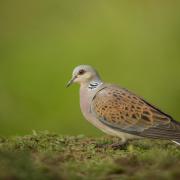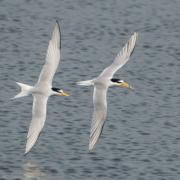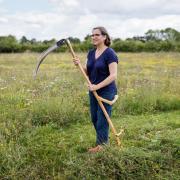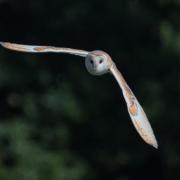Some of Suffolk's wetlands weave in and out of our industrial heritage. David Falk, manager of Discover Suffolk, buffs up his binoculars for a closer look and reveals some surprises
Some of Suffolk's wetlands weave in and out of our industrial heritage. David Falk, manager of Discover Suffolk, buffs up his binoculars for a closer look and reveals some surprises
Even as spring edges into summer, Suffolk’s low-lying landscapes still have a certain squelch about them.
There’s a real variety to choose from too: mushy marshlands, whispering reed-beds, the wettest of fens; the Stour’s stately water meadows, our beautiful Broadlands and even Levington’s very own lagoon.
But as the warmer days awaken the yellow flag irises in an outstretched yawn of waterside sunshine and mayflies do their seasonal stuff, fortunately there’s no strange instinct in Suffolk to reach for the flippers and indulge in a spot of bog snorkelling.
Safe in the knowledge that water scorpions do that sort of thing admirably, we take it all in our stride – even though our wellies may slip a bit here and there.
This is a great time of year to take a walk in squelchy Suffolk and enjoy its natural local colours, maybe do a bit of organised ponddipping with the little ones, or delve a little deeper into the past to reveal the story behind the watery landscapes.
In Suffolk, industrial heritage is hardly a dirty word. The busy bargelands of Constable’s Stour at Flatford and the quayside wharves once full of ‘shifters’ at Sudbury are now havens of culture and leisure.
Where our forefathers once dug peat, or harvested reeds and sedge at Oulton or on the fens at Redgrave and Lopham, seasonal visitors flock to bob about on the water.
At Snape’s Maltings near the coast, the industrious goings-on are more sedate these days, and alongside the Alde, which once bustled with precious cargos, otters and orchids grace the Snape marshes.
Even one-time gravel pits can become a pleasing place for a picnic, like those at Rodbridge near Long Melford – just a pea-shingle’s throw away from the candy-pink cottages of the once oh-so-industrious wool towns.
And elsewhere, these aggregate-stripped acres are simply a great venue for a few hours of hide and seek: if we get twitchy about Suffolk’s industrial heritage, it’s in a rather different way.
A peer down the resident long-lens, warmly situated inside the smart viewing gallery at Lackford Lakes, Suffolk Wildlife Trust’s nature reserve on the A1101 just north-west of Bury St Edmunds, ensures a bird’s eye view and puts everything into perspective.
The 121 hectare site, once mechanically scoured for its stoney resources, now incorporates the most natural wetland, woodland, scrub and heathland landscapes. Birds, dragonflies, even bats abound.
It’s a place full of contrasts, squelchy in parts, sandy in others and sandwiched between the subtle curves of the River Lark to the north and formal clipped greens of Flempton Golf Club.
A stroll between the dozen or so wellkept hides rewards with glittering prizes and lots of local colour: the light silver touch of early summer sun sparkling on the tips of the vast choppy waters of the sailing lake or the black and white blobs of geese bobbing by the island; the tiny beady-eyed dart of a sedge warbler flicking between the stalks of the purpling reeds; a round robin churping enquiringly from its perch on a woven willow fence; a shimmery-winged damselfly down by the faster flowing streams; perhaps even the early pinky promise of a Southern marsh orchid.
At this time of year, one colourful local resident steals the show. With its spindle-sharp beak and plumage that’s bluer even than the richest Lavenham Blew Broadcloth, the kingfisher is somehow a real Suffolk native, although recent harsh winters uncharacteristic for East Anglia have posed an ongoing challenge for the little chaps.
Muster your luck and patience by Jason’s Pool or in Bess’s hide down by Long Reach near the Lark and you could witness an unforgettable whizzpast that’s faster than a flying shuttle.
If more than just the early summer sun is shining on you, it’s not unheard of for the welldressed fellow to land, catch in beak, on a strategically positioned perch right in front of 4your binoculars.
According to the fossils unearthed by industry, bison, wolves and woolly mammoths once roamed this tranquil place of nightingale song, tree sparrow twitters, otters and irises – not an easy thing to imagine as you follow the goldfinches and chase the dragonflies down in Ash Carr or admire scuba-diving grebes and moorhens clambering over scribbles of tangled twig threads down by Hawker pool.
Take the pleasant walk between the pines and Plover Lake to Stegall’s hide on the furthest edge of the reserve and the view across Wilson’s Flood might lead past an oystercatcher or two and proud cormorants standing sentry in front of the unexpected pale mass of a 1940’s pill box.
Like the two concrete nesting walls built at the water’s edge elsewhere on the reserve, it makes for a bit of a modern surprise amongst the reedmace, but is a hit with the wildlife.
Originally part of the eastern command line stretching from Wivenhoe via Sudbury towards the Wash, this little bit of local history has been recycled into a ‘hibernaculum’ – in other words, a plush pad for a different sort of winged creature altogether: the reserve’s rare Barbastelle bats.
Find out more about your countryside from Discover Suffolk.
Discover Suffolk is Suffolk County Council’s project to improve access and raise awareness of Suffolk’s countryside. www.discoversuffolk.org.uk includes free downloadable leaflets for exploring the county on foot, by bike and on horseback.
There are details of countryside sites and events, nature and bird reserves and top tips on places to visit from a wide range of local personalities.


























